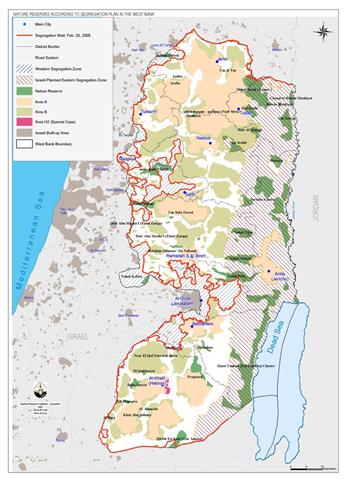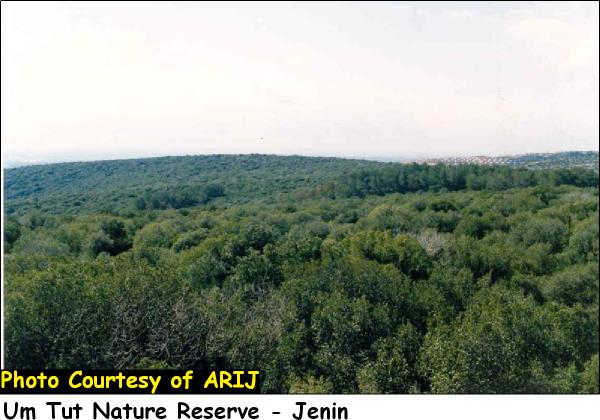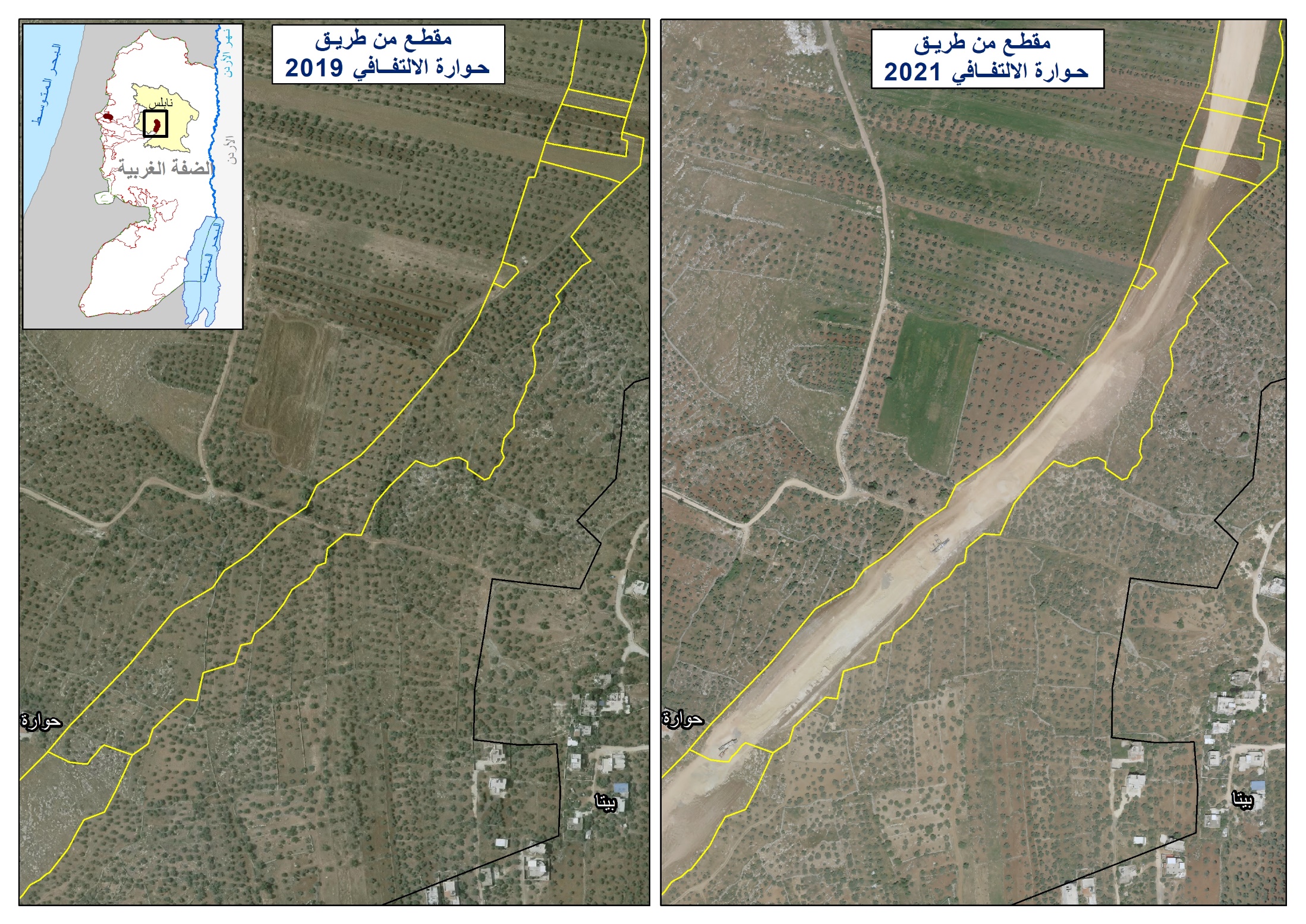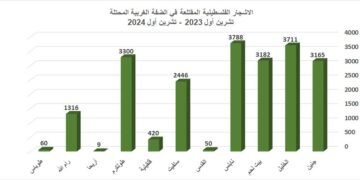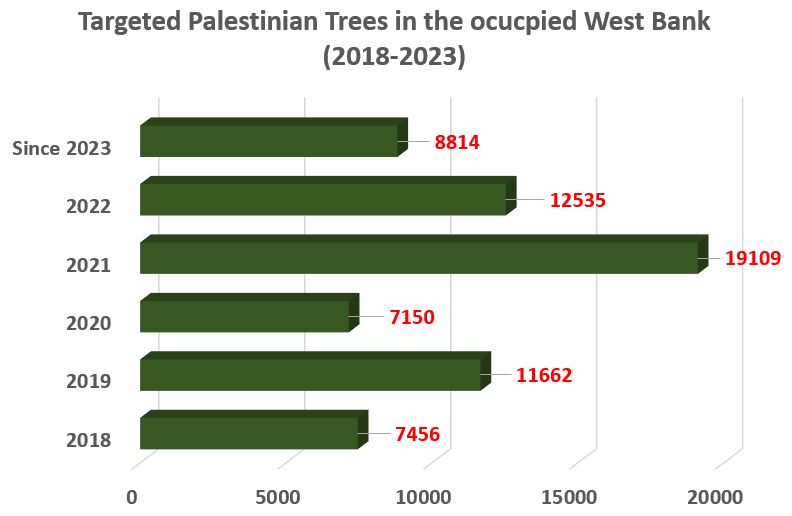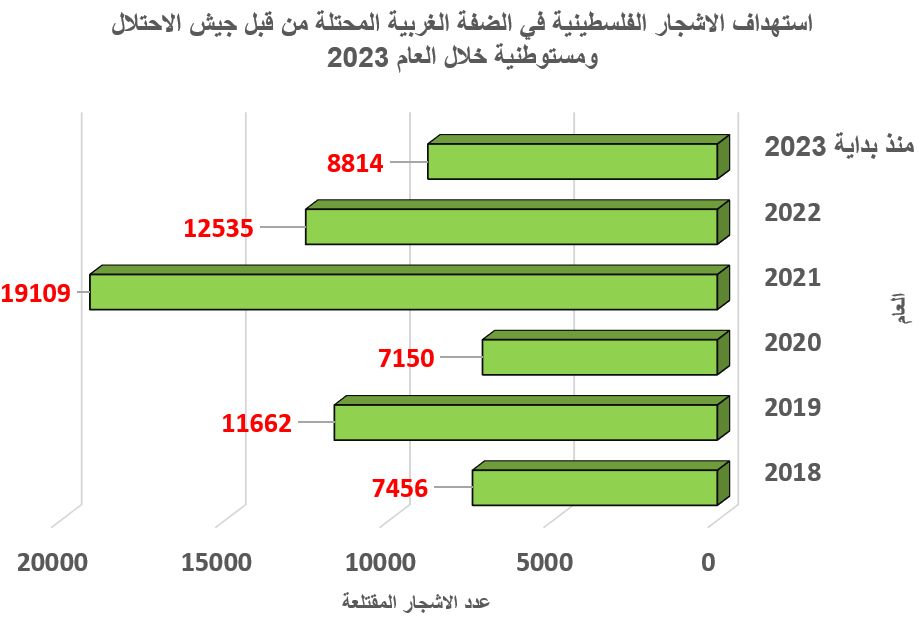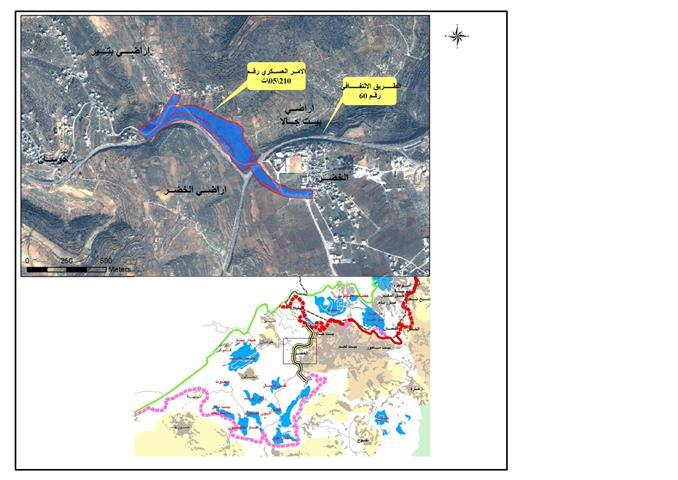Nature reserves in the West Bank
The nature reserve is defined by encyclopedia Britannica (2005) as the 'area set aside by a government for the purpose of preserving certain animals, plants, or both. The (IUCN,1994) defines the protected area as 'an area of land and/or sea especially dedicated to the protection and maintenance of biological diversity, and of natural and associated cultural resources, and managed through legal or other effective means.'
There are 36 nature reserves in the West Bank designated by Israel, 83% of which lie in area classified as C, where total control continues to be under the Israeli occupation. Only 9% of the nature reserves are located in area A, which was handed over to the Palestinians. The area of the nature reserves in area A constitutes only 10% of the total area designated as nature reserves in the West Bank. In these areas, the reserves are managed by the Palestinian ministry of agriculture. The following table shows the total number of nature reserves in the West Bank. See Table 1
|
Table one; the total number of natural reserves in the West Bank. |
||
|
Name |
Governorate |
Area/ Km² |
|
Al Mughayir (Nahal Bezek ) |
Tubas
|
55.837
|
|
Tayasir (Har Gadir) |
Tubas
|
10.627 |
|
Um Zawqa |
Tubas
|
24.586 |
|
Close to Ein El Bayda (Rotein Maskiyot) |
Tubas
|
5.230 |
|
El Musafeh (Haruva) |
Jericho
|
10.057 |
|
Fasayil |
Jericho
|
85.407
|
|
Ein Fash'ha |
Jericho
|
6.127 |
|
Deir Dibwan (Nahal Makuk) |
Ramallah
|
19.098 |
|
Mazare' En Nubani (Dalabim) |
Ramallah
|
4.134 |
|
El Taybeh (Kochav Hashahar) |
Ramallah
|
1.096 |
|
Kafr Malik (Nahal Yitav)
|
Ramallah
|
15.304 |
|
Deir Abu Masha'l (Einot Zarqa) |
Ramallah
|
3.814 |
|
Um Safa Forest
|
Ramallah
|
1.430 |
|
Beit Leqia (Nahal Kefira) |
Ramallah
|
4.775 |
|
Deir Ballut (Nahal Shiloh) |
Ramallah
|
15.134 |
|
Hizma (Nahal Prat) ; Wadi Qilt |
Jerusalem
|
29.807 |
|
Wadi el Bedan |
Nablus
|
27.981 |
|
Jisir al Malaqi
|
Nablus
|
18.541 |
|
Beit Imrin-National Park (Shomoron) |
Nablus
|
1.912 |
|
Araba |
Jenin
|
1.006 |
|
Um et Tut |
Jenin
|
0.743 |
|
Siris (open maquis – garigue ) |
Jenin
|
1.383 |
|
Reihan Forest |
Jenin
|
3.363 |
|
Kafr Thulth
|
Salfit
|
18.377 |
|
Bani Na'im (Proposed) |
Hebron
|
48.328 |
|
Al Qaran
|
Hebron
|
1.141 |
|
Abu Soda |
Hebron
|
0.866 |
|
Kh Efqaqees
|
Hebron
|
1.743 |
|
Khal Abu Ashara
|
Hebron
|
3.513 |
|
Al Alamieh
|
Hebron
|
0.902 |
|
Al Burj
|
Hebron
|
1.665 |
|
Hirbit En Nabi (Har Amasa) ; Jabal Khold |
Hebron
|
12.695 |
|
El Qof Forest
|
Hebron
|
4.042 |
|
Suba Forest
|
Hebron
|
11.584 |
|
Ein Fash'ha; Ein Gedi |
Bethlehem
|
123.170 |
|
Wadi Khratoon -National Park (Herdium) |
Bethlehem
|
3.164 |
|
|
|
|
|
Total |
578.582 km2 |
|
Nature reserves and the Segregation Wall
The Segregation Wall is imposing extra stress on the status and management of the nature reserves. The Wall is causing degradation to the water, agricultural and natural resources and biodiversity in the West Bank including: water resources, natural pasture land, forests, nature reserves and the agricultural areas, thus endangering the sustainability of the natural resources in the West Bank.
The Segregation Wall being constructed at the western part of the West Bank is creating a segregation zone west of it, this zone is restricted to the Palestinians who own these lands, unless they obtain special permits from the Israelis (which are very hard to obtain). The Israelis are maintaining another segregation zone at the eastern part of the West Bank parallel to Jordan River and the western shores of the Dead Sea, but without physical barriers. The segregation is maintained by blocking the Palestinian movement to the zone by imposing checkpoints and road barriers.
More than 23 nature reserves are included in the Israeli Segregation Zones (Eastern and Western). The area of nature reserves that are isolated between the western Segregation Wall and the Green line is approximately (32237 dunoms) 32.237 Km², while the area of the nature reserves located in the eastern segregation zone is 376.624 km2. Thus, the total area of the nature reserves segregated constitutes 71% of the area of the nature reserves in the West Bank. This action will threat the existence of the unique flora and fauna by confining several species to isolated habitats and reducing the population size below the minimum viable population. The following table shows the total number of the nature reserves in the Israeli Segregation Zones (Eastern and Western). See Table 2
|
Table two; The total number of nature reserves in the Eastern and Western Segregation Zones |
|
|
Eastern Segregation Zone |
Area/ Km² |
|
|
|
|
Close to Rotein Maskiyot (Ein El Bayda) |
4.131 |
|
Einot Tzukim (Ein Fash'ha) Cluster |
129.135 |
|
El Musafeh (Haruva) |
8.274 |
|
Jisir Al Malaqi |
6.645 |
|
Al Mughayir (Nahal Bezek) |
46.009 |
|
Deir Dibwan (Nahal Makuk) |
18.870 |
|
Hizma (Nahal Prat) |
15.123 |
|
Kafr Malik (Nahal Yitav) |
15.304 |
|
Ein El Bayda (Rotein Maskiyot) |
1.099 |
|
Um Zawqa |
24.586 |
|
Fasayil |
84.668 |
|
Tayasir (Har Gadir) |
9.204 |
|
El Taybeh (Kochav Hashahar)
|
1.096
|
|
Wadi el Bedan
|
12.480
|
|
Total |
376.624 |
|
|
|
|
Western Segregation Zone |
Area/Dunums |
|
|
|
|
Abu Soda |
0.535 |
|
Al Burj |
0.223 |
|
Hirbit En Nabi (Har Amasa) |
2.330 |
|
Beit Leqia (Nahal Kefira) |
4.767 |
|
Deir Ballut (Nahal Shiloh) |
6.247 |
|
Reihan Forest |
3.363 |
|
Kafr Thulth |
11.399 |
|
Hizma (Nahal Prat)
|
1.203
|
|
Al Mughayir (Nahal Bezek ) |
2.170
|
|
Total |
32.237 |
|
|
|
|
Total |
408.861 |
In addition, the largest nature reserves in the western slopes of the West Bank, namely Kafr Thulth and Nahal Shilo in Salfit Governorate will be physically fragmented by the Wall. The environmental impact of fragmenting the forest of Kafr Thulth and in disrupting the natural water flow of the stream and springs in Nahal Shilo needs to be diligently investigated, as the physical barrier would not only disrupt the contiguity of the landscape and the movement of water and biota but also the possible different future management policies and institutions acting on both sides of the Wall, thus jeopardizing the development of an integrated plan for the conservation of the landscape and the biodiversity in these nature reserves.
However, it is not foreseen that Palestinians would exercise management responsibilities in these reserves. It can be stated that while several nations are moving towards the creation of tarns boundary national reserves that are well known to promote conservation across larger contiguous areas of habitat, the fragmentation of nature reserves can have potential adverse impacts on securing migratory pathways and other ecosystem services. See map 1
Analysis of the route of the Segregation Wall revealed that the Wall diverts east of the Armistice line (the green line) to grab Palestinian nature reserves in 9 locations in the West Bank. These nature reserves are: Reihan forest in Jenin which is completely segregated west of the Segregation Wall; Kafr Thulth in Salfit where 62% of the nature reserve will be segregated; Deir Ballut (Nahal Shiloh) in Ramallah governorate where 41% of the reserve will be segregated behind the Wall; Beit Leqia (Nahal Kefira) in Ramallah govrnorate where all of the nature reserve will be segregated west of the Wall; Hizma-Wadi Qilt (Nahal Prat) in Jerusalem Governorate where 4% of the reserve will be segregated; Abu Soda in Hebron governorate where 62% of the reserve will be segregated and included within the Gush Etziyon Settlement bloc; Al Burj in Hebron Governorate where 14% of the reserve will be segregated west of the Wall; Hirbit En Nabi (Har Amasa) in Hebron governorate where 18% of the reserve will be segregated south of the Segregation Wall; in addition to Al Mughayir (Nahal Bezek) in tubas Governorate where 4% of the reserve will be segregated north of the Segregation Wall and 82% of it will be segregated in the eastern segregation zone. See Photo 1
Nature reserves converted to Israeli settlements?
Throughout the 38 years of Israeli occupation, the Israeli authorities have classified 36 locations as nature reserves that have to be protected. The Palestinians were prevented from cultivating these areas or using it for any other purpose. However, it is worth mentioning that some of the nature reserves were transferred to Israeli settlements or Israeli military bases. The following table shows the nature reserves in the West Bank that were transferred to Israeli Settlements and military bases. See Table Three
|
Table three; the total number of the nature reserves in the West Bank that have been destroyed by the construction of Israeli settlements. |
|||
|
|
|
|
|
|
Name of nature reserve |
Area |
Settlement |
Nature reserve area consumed by Israeli settlement /Km² |
|
Wadi el Bedan |
28 |
Elon Moreh |
0.133 |
|
Beit Leqia (Nahal Kefira) |
5 |
Mevo Horon |
0.080 |
|
Bani Na'im (Proposed) |
48 |
Asfar ( Mitzad) |
0.203 |
|
Abu Soda |
1 |
Allon Shevut |
0.000 |
|
El Qof Forest |
4 |
Telem |
0.098 |
|
Close to Ein El Bayda (Rotein Maskiyot) |
4 |
Shadmot Mehola |
0.004 |
|
Um Zawqa |
25 |
Hemdat |
0.004 |
|
Deir Ballut (Nahal Shiloh) |
15 |
Beit Arye |
0.687 |
|
Ein Fash'ha |
123 |
'Ayn Fashkhah |
0.422 |
|
El Taybeh (Kochav Hashahar) |
1 |
Kokhav haShahar |
0.063 |
|
Hirbit En Nabi (Har Amasa) |
13 |
Susiya |
0.003 |
|
Hizma (Nahal Prat) |
30 |
Sha'ar Benyamin |
0.420 |
|
Kafr Thulth |
18 |
Ma'ale Shamron |
1.322 |
|
Mazare' En Nubani (Dalabim) |
4 |
Dolev |
0.069 |
|
Um Safa Forest |
2 |
Hallamish |
0.103 |
|
Wadi Khratoon -National Park (Herdium) |
3 |
Tekoa (includin Tekoa C,D) |
0.462 |
|
Total
|
324 Km² |
4.073 km² |
|
Political agreements and nature reserves
A review of the agreements between the Israelis and Palestinians relevant to the environment and conservation of biodiversity and nature reserves has reveled the following:
-
In the declaration of principles on Interim Self-Government Authority (Oslo I Accords, 1993), environmental issues did not receive much attention. It was agreed that '[i]n order to enable the Council to promote economic growth, upon its inauguration, the Council will establish, among the things, The Palestinian Environmental Authority, a Palestinian Land Authority and a Palestinian Water Administration Authority, and any other Authorities agreed upon, in accordance with the Interim Agreement that will specify their powers and responsibilities. (Article VII Interim Agreement, Clause 4). In ANNEXII: Protocol on withdrawal of Israeli forces from the Gaza Strip and Jericho area 'The two sides agree to establish an Israeli-Palestinian Continuing Committee for Economic Cooperation, focusing, among other things, on the following An Environmental Protection Plan, roving for joint and/ or coordinated measures in this sphere.' (article 10).
· In the Oslo II interim agreement (1999) annex III, Protocol Concerning Civil Affairs, article IV – Special Provisions concerning Area C, several articles specifically dealt with the transfer of powers and responsibility from the Israeli military government and its Civil Administration to the Palestinian Council in the spheres of nature reserves (Article 25), parks (Article 26), Archeology (Article 2), Forests (Article 14) and environmental protection (Article 12).
-
In the Wye Rive memorandum of October 23, 1998, article 1, clause 1 the 'Palestinian side has informed that it will allocate an area/areas amounting to 3% from the [12% transferred from Area C to area B to be designated as Green Areas and/or Nature Reserves. The Palestinian side has further informed that they will act according to the established scientific standards, and that therefore there will be no changes in the status of these areas, without prejudice to the rights of the existing inhabitants in these areas including Bedouins; while these standards do not allow new construction in these areas, existing roads and buildings may be maintained. The Israeli side will retain in these Green Areas/Nature Reserves the overriding security responsibility for the purpose of protecting Israelis and confronting the threat of terrorism. Activities and movements of the Palestinian Police forces may be carried out after coordination and confirmation; the Israeli side will respond to such requests expeditiously.'
Conclusion:
The Government of Israel continued to follow a policy that aimed at annexing more Palestinian lands and violating its obligations under the Fourth Geneva Convention and UN resolution among which are resolutions 242, 336, 446 (1979) related to settlements in the Arab territories occupied since 1967, including Jerusalem. Articles from the International law that demand the protection of natural environment:
Protocol Additional to the Geneva Conventions of 12 August 1949, and relating to the protection of Victims of International Armed Conflicts (Protocol I), 8 June 1977 , Article 55 Protection of the natural environment;
1. 'Care shall be taken in warfare to protect the natural environment against widespread, long-term and severe damage. This protection includes a prohibition of the use of methods or means of warfare which are intended or may be expected to cause such damage to the natural environment and thereby to prejudice the health or survival of the population.
2. 'Attacks against the natural environment by way of reprisals are prohibited'
Under the Israeli-Palestinian Interim Agreement on the West Bank and the Gaza Strip Annex III, Protocol Concerning Civil Affairs, Article 12 Environmental Protection, clause 14, 'Israel and the Palestinian side shall cooperate in implementing principles and standards, which shall conform with internationally accepted principles and standard ,concerning the protection of endangered species and of wild fauna and flora, including restriction of trade, conservation of migratory species of wildlife and preservation of existing forests and nature reserves'. So the Israeli policies of land confiscation, nature reserve destruction and natural resource degradation are against international laws and resolutions.
According to the Palestinian environment law number (7) for a year 1999:
-
Article (40) 'the ministry, in cooperation with competent authorities, shall designate bases and criteria to maintain natural reserves and national parks, supervising, announcing and demarking them'.
-
Article (41) 'it shall be banned to hunt, kill or catch land birds, land and maritime animals and fish itemized in the executive list of this law. It shall be prohibited, too, to own, transfer, wander with or display such birds and animals either dead or alive; their nets and eggs shall not to be destroyed'.
-
Article (42) 'the ministry shall designate necessary conditions to maintain vital variety in Palestine, in collaboration with competent authorities'.
-
Article (43) 'The ministry , in coordination with competent authorities, shall undertake setting sufficient fundamentals and criteria to itemize plants, forest and land trees that can not be cut, cultivated, damaged, either temporarily or permanently to guarantee their continuity and perpetuity'.
-
Article (44) 'anyone shall be banned to do any activities and behavior leading to endangering natural preserves, forest areas, public parks, historical and archeological sites or affect aesthetic level of such areas'.
-
Article (72) 'Anyone who violates provisions of article (44) of this law shall be punished by a fine not less than twenty Jordanian dinars (JD) but not more than two hundred dinars (JD) or their equal in the legally active currency or jail for not less than three days but not more than one month or by one of the two penalties'.
Reference;
-
Arij databases. ARIJ archives. 18 Oct 2005
-
Israeli-palestinian Interim Agreement on the West Bank and Gaza Strip. Jerusalem: , 1995.
-
IUCN (1994). Guidelines for Protected Areas Management Categories. IUCN, Cambridge, UK and Gland, Switzerland. 261pp.
-
Palestinian National Information Centre. 1999. Chairman of the Executive committee of Palestine Liberation Organization . 23 Oct. 2005 <click here for the link>. >.
-
'Nature reserve.' Encyclopdia Britannica. 2005. Encyclopdia Britannica Premium Service. 6 Dec. 2005 <http://www.britannica.com/eb/article-9055051>.>.
-
'Office of the High Commissioner for Human Rights .' Protocol Additional to the Geneva Conventions of 12 August 1949, and relating to the Protection of Victims of International Armed Conflicts (Protocol 1). 24 Oct. 2005 <Click Here for the Link>.
Prepared by:
The Applied Research Institute – Jerusalem


